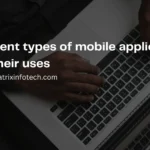Step 1: The first step of mobile app development is initial planning. In this vision, the idea and goal of the mobile app are discussed.
Purpose: Why is there a need for app development? Are you ready to spend money? Is your idea appropriate for the app? What problem have you faced in your business? How will your business benefit from app design?
USPs of your business: Prepare a blueprint of products and services unique to your business. Differentiating components, attracting potential, etc.
Research your competitors: Proper analysis of business competitors is necessary. Wireframing of leading business firms that are flourishing through mobile app development.
Investment strategy: The best app development companies need to be selected as part of the investment protocol. The app development budget is mandated with requirement analysis. With proper mobile app planning, the hiring of an app developer is done. Furthermore, the app development timeline is prepared.
Step 2: The second step is the market analysis. Market research is done to find out the needs, requirements, interests, and demands of the market. Mobile app development consultants are approached to gather information about the competition in the market. User research is also the decisive action for mobile app designs.
Benefits of Market Research: It helps developers and business entrepreneurs get accustomed to the customer’s needs. This will help to gain a clear idea about the competitor’s mobile apps. Moreover, it will enable developers and entrepreneurs to determine the end goals and evaluate the product before its launch.
Step 3: Wireframing of the App is the third and most important process of mobile app development. When the ideas, goals, and purpose of app development are prepared, then the planning of the app will help create a mobile app development checklist. Afterwards, project management is done to facilitate the process of app development.
Preparation of app infrastructure: In this stage, the app developer will decide what kind of app infrastructure is needed for hybrid or react-native app development. The complete listing of technology, software, programming, etc. is decided. The framework for backend and frontend development is prepared during this stage. Thereafter, designing the framework is done after getting information about the thoughts and ideas of the business.
Step 4: UI/UX design is the fourth step of mobile app development. Here, the developer gets a brief outlook on the values attached to the products and services of the business. User interface design and user experience design are of prime importance. The mobile app design process leverages the emotional values and ideational principles of the business. The iOS and Android platforms have their native designs. When developers focus on hybrid app development, then UI/UX designs are common.
The mobile app design is an attractive feature of development. However, these designs will affect the user’s engagement with the mobile app.
Step 5: The style guidance of the mobile app is the fifth step in development. This process involves the iterative development of the app. It is embodied in performance standards, branding guidelines, and the functionality of the app. The major components of a style guide are colours, fonts, graphics, etc. The user interface elements are added here.
Step 6: In the sixth step of mobile app development, fidelity designs are prepared. The combination of style guide and wireframe is done here to create a mockup. It will give a brief idea of the app presentation. Cross-platform apps and native apps are encompassed with app analytics to ensure high performance. Developmental tools are fabricated in a user-friendly way.
Step 7: App prototyping is the seventh step of the mobile app development phase. This step involves user feedback collection. The technical documentation of the app is confirmed in prototyping. Design simulation is leveraged to develop user retention strategies. App prototyping is crucial to getting the idea of client-side development.
Step 8: After completion of the design part, the demography of the mobile application is developed. The process contained various parameters that needed to be fulfilled. Here, backend development is done primarily where data processing is done. Cloud API integration is done to build a support base for the mobile app. Source control occurs during this mobile app development phase. Server-side development is formulated during this app development stage.
Simultaneously, front-end development is done to create interactive user experiences. User-interface elements and the user onboarding process are combined in this stage. The technical documentation of the app is linked to an API to get interactive designs. Incident management is ensured here to obtain better engagement.
Step 9: In this stage of mobile app development, testing is done. It is done to verify whether the mobile app is working fine or not. Quality assurance app testing plays a major part in the development of mobile applications. App security checking is also done at this stage to ensure encryption and end-to-end management of the mobile app. Afterwards, performance testing is monitored to ensure the functionality of the app. When performance tuning is catered to effectively, the app becomes viable for further stages. Cross-platform testing is enabled to validate the practical workings of mobile applications. The above-mentioned testing is a pivotal part of mobile app development before the launch. If bug reporting is found during testing, debugging is performed, and loopholes in the app development are mitigated.
Step 10: App Launch is the final stage of mobile app development. The app deployment is done on various platforms for wider accessibility. The metadata of the app is released during this stage to ensure the feasibility of its usage. This is done so that people can search for a particular app without any problems. Post-launch reviewing is done by various platforms. Once it is done, version control is formulated to ensure software upgrades. However, version management will help with bug tracking. Legal compliance with the app is also analyzed to ensure its smooth functioning.







